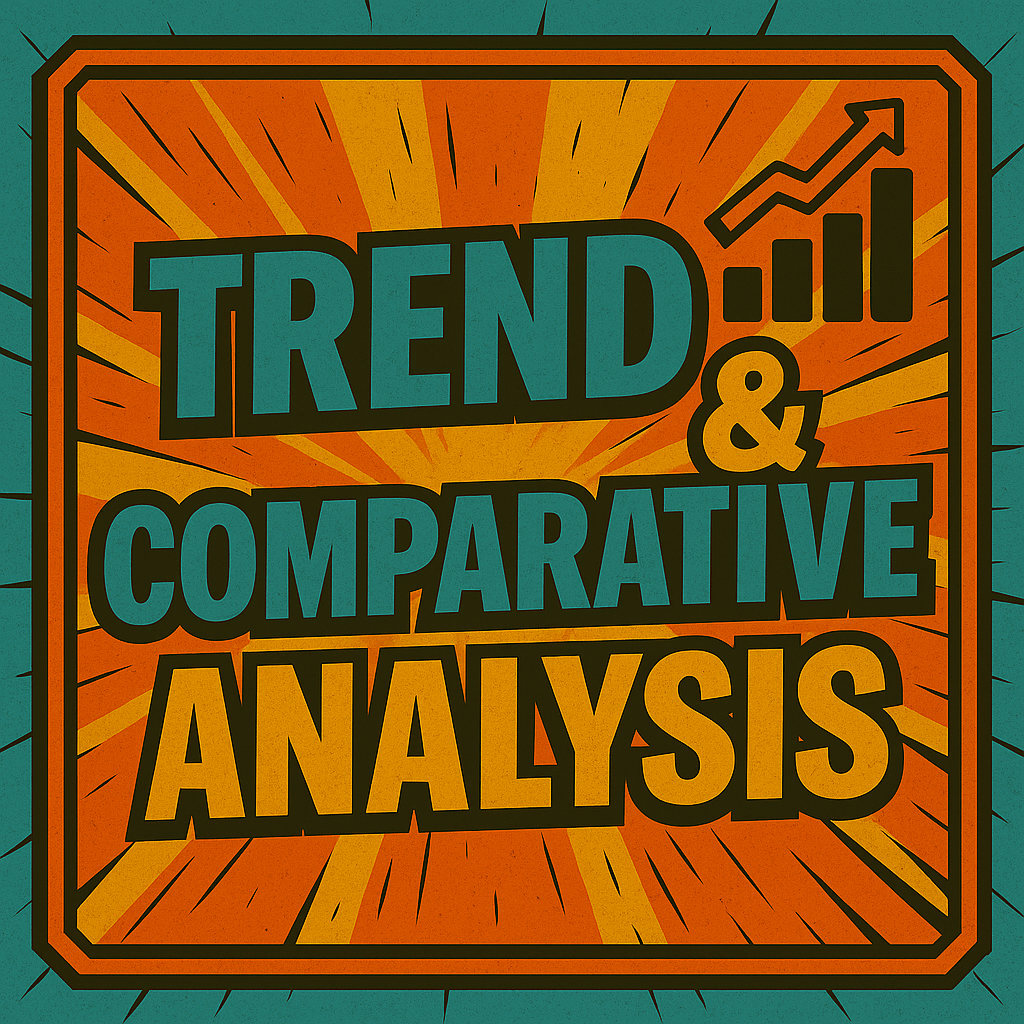
Trend & Comparative Analysis
“Your Data’s Got Eyes”
Track What’s Changing - and How the Business Stacks Up
Trend & Comparative Analysis combines two powerful tools:
Trend Analysis – Spotting performance shifts over time.
Comparative Analysis – Benchmarking results against past periods, competitors, industry norms, or budget forecasts.
Together, they provide the insight to:
📈 See momentum clearly – growth, decline, or stagnation
🚦 Spot red flags early – before they hit the bottom line
📊 Understand context – is that margin good or bad?
🔍 Drill into anomalies – uncover what’s driving change
🎯 Make better, faster decisions – based on performance and position
Trend Analysis (MoM & YoY)
🔄 Month-over-Month (MoM)
- Use for: short-term shifts, tactical moves, seasonal patterns
- Example: “Marketing costs spiked 15% MoM. What caused it?”
📆 Year-over-Year (YoY)
- Use for: long-term growth, recurring patterns, normalizing seasonality
- Example: “This October’s profit margin is 3% higher than last year’s.”
Comparative Analysis
Compare performance against:
Industry Benchmarks (via NAICS, trade associations, or databases)
Historical Periods (vs. last quarter, last year)
Budget or Forecast (vs. what you planned to do)
Peer Businesses (if data is available)
Product Lines or Locations (internal comparison)
Example Use Cases
Owner: “Our Q3 revenue looks flat—until we compare to last year, where it’s actually up 18%.”
Banker: “This client’s profit margin is strong, but 5% below the industry average. What’s the story?”
Controller: “Sales are up, but costs are rising faster—time for a pricing review.”
Ops Leader: “Product B is outperforming Product A on margin. Should we shift focus?”
Example Comparison Types in Trend & Comparative Analysis
| Comparison Type | Application/Relevance |
|---|---|
| Year-over-Year (YoY) Growth | Are we scaling sustainably over time? Helps normalize seasonality and track long-term progress. |
| Month-over-Month (MoM) Change | What changed this month? Spot early trends or volatility before they become problems. |
| Margin vs. Industry Average | Are we pricing and managing costs effectively? Reveals competitiveness and profitability health. |
| Actual vs. Forecast/Budget | Are we executing as planned? Highlights deviations in performance, spending, and results. |
| Product A vs. Product B | Which offering is more profitable? Guides product development, marketing, and pricing strategies. |
| Customer Segment A vs. Segment B | Which customer group delivers more value? Helps tailor marketing, pricing, and service levels. |
| This Quarter vs. Last Quarter | Are we improving operationally over time? Useful for spotting short-term execution shifts. |
| Revenue per Employee (vs. Past or Peers) | Are we scaling efficiently? A great internal productivity benchmark. |
| Sales Channel A vs. Channel B | Where are we getting the best return? Compares ROI on wholesale, retail, DTC, or online platforms. |
| Cost per Acquisition (CPA) vs. Lifetime Value (LTV) | Is our growth model profitable? Critical for marketing and growth decisions. |
| Territory/Region A vs. B | Which geography is outperforming? Useful for expansion, staffing, or territory planning. |
| Current vs. Prior Period Inventory Turns | Are we managing inventory better? Tracks capital efficiency in product-based businesses. |
| Gross Profit YoY vs. COGS YoY | Are our margins improving or compressing? Tells you whether revenue is translating into better profit. |
| AR/AP Turnover vs. Industry | Are we managing cash flow efficiently? Indicates liquidity and operational discipline. |
| Marketing Spend vs. Revenue Impact | Is our spend generating returns? Tracks campaign efficiency and sales funnel effectiveness. |

Final Thought
Data without context is just noise.
You can’t manage what you don’t understand—and that’s where trend and comparative analysis comes in.
By layering time-based trends with performance benchmarks, you turn static numbers into living insights.
This kind of analysis doesn’t just tell you what happened—it shows you why it happened, how you’re doing compared to where you should be, and where to focus next.
It’s the difference between running a business reactively… and running it intentionally.
Look at the direction, not just the data. Make trend review a habit. Compare with purpose. Act with confidence.
The clarity created today is what drives tomorrow’s results.

